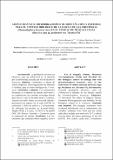Mostrar el registro sencillo del ítem
Abono orgánico, microorganismos de montaña (Mm) y fertibiol para el control biológico de la hernia de la crucíferas (Plasmodiophora brassicae wor.) en el cultivo de mostaza china (Brassica rapa sp. pekinensis var. Taranko F1)
| dc.creator | Castro Barquero, Leida | |
| dc.creator | Martínez Vargas, Verónica | |
| dc.creator | Castro Zúñiga, Oscar | |
| dc.creator | Blanco Meneses, Mónica | |
| dc.date.accessioned | 2021-01-26T19:17:25Z | |
| dc.date.available | 2021-01-26T19:17:25Z | |
| dc.date.issued | 2020 | |
| dc.identifier.citation | https://revistas.ucr.ac.cr/index.php/agrocost/article/view/43088 | |
| dc.identifier.issn | 2215-2202 | |
| dc.identifier.issn | 0377-9424 | |
| dc.identifier.uri | https://hdl.handle.net/10669/82604 | |
| dc.description.abstract | Introducción. La producción de mostaza (Brassica rapa sp. pekinensis) se ve afectada por la enfermedad causada por Plasmodiophora brassicae. Objetivo. Determinar el efecto de Abono Orgánico, Microorganismos de Montaña y Fertibiol, para el control biológico de P. brassicae. Materiales y métodos. Los tratamientos diseñados se evaluaron de manera individual y en combinación, las variables evaluadas fueron peso fresco y seco de la parte aérea y la radical, relación raíz-tallo, índice de severidad radical y persistencia de esporas en el suelo (rtPCR). Se realizaron 2 ciclos de cultivo y 2 evaluaciones. Se utilizaron las pruebas de Kruscal-Wallis, Shapiro-Wilks y Levene, ANDEVA y la prueba DGC (Di Rienzo, Guzmán y Casanoves) para la separación de medias. Resultados. Los tratamientos que contenían abono orgánico (solo o en mezcla) obtuvieron los mayores valores para las variables de peso fresco y seco, tanto para la parte aérea (más de 300% respecto al testigo) como la radical. La relación raíz-tallo (R/T) fue menor y, por ende, más favorable en el tratamiento con abono orgánico, con un valor de 0,22. Para el índice de severidad, el tratamiento con MM presentó el menor valor en las 2 evaluaciones, mientras que los tratamientos con abono orgánico mostraron el mayor valor, pero esto no afectó negativamente el rendimiento. Para la variable persistencia, fue posible determinar que en el testigo hubo una disminución en la cantidad de esporas germinativas con el avance del tiempo y que los tratamientos aplicados ocasionaron respuestas variables en cuanto a este comportamiento, mostrando ecuaciones con diferente pendiente y muy diversos coeficientes de variación. El tratamiento con MM presentó para la segunda evaluación la menor cantidad promedio de esporas y el menor índice de severidad radical. Conclusión. El abono orgánico mejoró el rendimiento de las plantas y la utilización de MM redujo la severidad y mostró potencial para disminuir la presencia de esporas en el suelo. | es_ES |
| dc.description.abstract | Introduction. Mustard production (Brassica rapa sp. Pekinensis) is affected by the disease caused by Plasmodiophora brassicae. Objective. To determine the effect of Organic Matter, Mountain Microorganisms and Fertibiol, for the biological control of P. brassicae. Materials and methods. The designed treatments were evaluated individually and in combination, the variables evaluated were fresh and dry aerial and radical weight, root-stem ratio (R/T), radical severity index and spore persistence in the soil (rtPCR). Two culture cycles and 2 evaluations were performed. The Kruscal-Wallis, ShapiroWilks and Levene, ANDEVA tests and the DGC (Di Rienzo, Guzmán & Casanoves) test for the separation of means were used. Results. The treatments containing organic matter obtained the highest values for the variables of fresh weight and dry weight, both for the aerial part (more than 300% compared to the control) and the radical part. The R/T ratio was lower, and therefore more favorable, in the treatment with organic matter, with a value of 0.22. For the severity index, the MM treatment had the lowest value in the 2 evaluations, while the treatments with organic matter showed the highest value, but this did not affect the yield negatively. For the persistence variable, it was possible to determine that in the control treatment there was a decrease in the amount of germinating spores with the advance in time and that the treatments applied caused variable responses regarding this behavior, showing equations with different slopes and very different coefficients of variation. The treatment with MM presented for the second evaluation the lowest average amount of spores and the lowest radical severity index. Conclusion. The organic matter improved the yield of the plants and the use of MM reduced the severity and showed potential to reduce the presence of spores in the soil. | es_ES |
| dc.description.sponsorship | Universidad de Costa Rica/[]/UCR/Costa Rica | es_ES |
| dc.language.iso | es | es_ES |
| dc.source | Agronomía Costarricense, vol.44(2), pp.31-49 | es_ES |
| dc.subject | Plasmodiophora brassicae | es_ES |
| dc.subject | Hernia de las crucíferas | es_ES |
| dc.subject | Microorganismos de montaña (MM) | es_ES |
| dc.subject | Abono orgánico | es_ES |
| dc.subject | Fertibiol | es_ES |
| dc.subject | Control biológico | es_ES |
| dc.subject | Cabbage clubroot | es_ES |
| dc.subject | Mountain microorganisms (MM) | es_ES |
| dc.subject | Organic matter | es_ES |
| dc.subject | Biological control | es_ES |
| dc.title | Abono orgánico, microorganismos de montaña (Mm) y fertibiol para el control biológico de la hernia de la crucíferas (Plasmodiophora brassicae wor.) en el cultivo de mostaza china (Brassica rapa sp. pekinensis var. Taranko F1) | es_ES |
| dc.title.alternative | Use of Organic Matter, Mountain Microorganisms (MM) and Fertibiol for the biological control of cabbage club root (Plasmodiophora brassicae wor.) in the cultivation of chinese mustard (Brassica rapa sp. Pekinensis var. Taranko F1) | es_ES |
| dc.type | artículo original | |
| dc.identifier.doi | 10.15517/RAC.V44I2.43088 | |
| dc.description.procedence | UCR::Vicerrectoría de Investigación::Unidades de Investigación::Ciencias Agroalimentarias::Centro de Investigaciones Agronómicas (CIA) | es_ES |
| dc.description.procedence | UCR::Vicerrectoría de Investigación::Unidades de Investigación::Ciencias Agroalimentarias::Centro de Investigación en Protección de Cultivos (CIPROC) | es_ES |
Ficheros en el ítem
Este ítem aparece en la(s) siguiente(s) colección(ones)
-
Agronomía [1485]
-
Agronomía Costarricense 44(2) [4]


